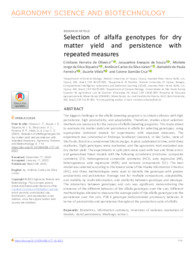Selection of alfalfa genotypes for dry matter yield and persistence with repeated measures.
Selection of alfalfa genotypes for dry matter yield and persistence with repeated measures.
Autoria: OLIVEIRA, C. F. de; SOUZA, J. E. de; SIQUEIRA, M. J. da S.; SILVA JÚNIOR, A. C. da; FERREIRA, R. de P.; VILELA, D.; CRUZ, C. D.
Resumo: The biggest challenge in the alfalfa breeding program is to obtain cultivars with high persistence, high productivity, and adaptability. Therefore, studies about selection methods are necessary for the success of alfalfa breeding programs. This study aimed to evaluate dry matter yield and persistence in alfalfa for selecting genotypes, using appropriate statistical models for experiments with repeated measures. The experiment was conducted at Embrapa Southeast Livestock, in São Carlos, state of São Paulo, Brazil in a randomized blocks design, in plots subdivided in time, with three replicates. Eight genotypes were evaluated, and the agronomic trait evaluated was dry matter yield. The experiments in split-plots were used with two and three errors and generalized linear models with the following correlation structures: composite symmetry (CS), heterogeneous composite symmetry (HCS), auto regressive (AR), heterogeneous auto regressive (HAR), and variance components (VC). The best model was selected according to the lowest value of the Akaike Information Criterion (AIC), and three methodologies were used to identify the genotype with greater productivity and persistence: Average test for multiple comparisons, adaptability, and stability by multi-information, and similarity between genotype and ideotype. The interaction between genotypes and cuts was significant, demonstrating the existence of the different behavior of the alfalfa genotypes over the cuts. Different methodologies allowed to measure the average yield of the alfalfa genotype and the persistence over the cuts. PSB 4 genotype demonstrated promissory behavior in terms of productivity and persistence throughout the production cycle of alfalfa.
Ano de publicação: 2023
Tipo de publicação: Artigo de periódico
Unidade: Embrapa Pecuária Sudeste
Palavras-chave: Biometria, Genótipo, Matéria Seca, Medicago Sativa
Observações
1 - Por padrão são exibidas publicações dos últimos 20 anos. Para encontrar publicações mais antigas, configure o filtro ano de publicação, colocando o ano a partir do qual você deseja encontrar publicações. O filtro está na coluna da esquerda na busca acima.
2 - Para ler algumas publicações da Embrapa (apenas as que estão em formato ePub), é necessário ter, no celular ou computador, um desses softwares gratuitos. Sistemas Android: Google Play Livros; IOS: iBooks; Windows e Linux: software Calibre.
Acesse outras publicações
Acesse a Base de Dados da Pesquisa Agropecuária (BDPA) para consultar o acervo completo das bibliotecas da Embrapa.

